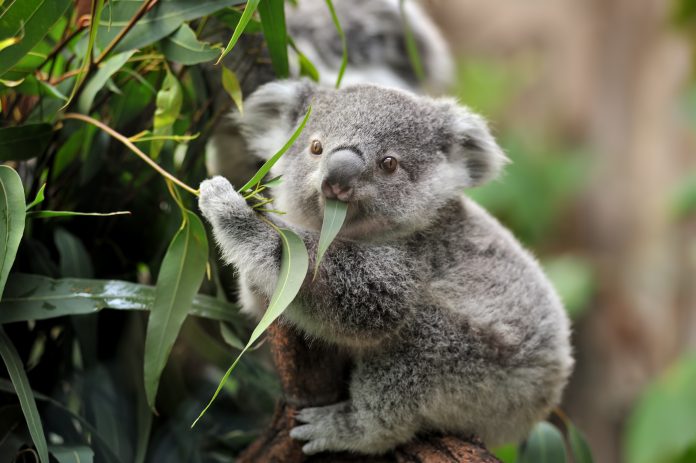Dr Stuart Blanch from WWF-Australia, calls attention to the risk of koala extinction on Australia’s east coast by 2050 and sheds light on what can be done to save this iconic species
More plush koala toys are likely in Australia’s souvenir shops than real koalas living in our forests and woodlands.
The driving force of Koala extinction
Koalas are the “face” of Australia’s eucalypt forests – just as giant pandas are an emblem of China’s bamboo forests and orangutans have come to represent the fate of Borneo’s rainforests.
The species is synonymous with Australia. And it is being driven towards extinction on Australia’s east coast by 2050.
The causes are varied and difficult to mitigate – global heating, deforestation, chlamydia, native forest logging, dog attacks and collisions with cars and trucks.
The Australian Government estimates approximately 300,000 to 600,000 wild koalas are remaining in Australia today.
This number is dwarfed by the estimated 800,000 koalas that were shot in Queensland alone in August 1927 during a government-endorsed open hunting season named “Black August”.
The hunt brought to a close a shocking pelt trade that saw eight million koala hides exported to the United States, United Kingdom and Canada between 1888 and 1927.
Koala numbers declined over the past century
While the fur trade ended nearly a century ago, East Coast koala numbers declined again in the second half of the twentieth century as deforestation cleared millions of hectares of forests.
The koala was formally listed as an endangered species on Australia’s east coast in February 2022, based on scientific advice the koala population had halved between 2000 and 2020.
Bulldozing and logging of native forests and woodlands destroys and fragment around 400,000 hectares each year.
Citizens, retailers, and financial institutions in the U.S., Canada, Europe, and Japan may unknowingly participate in this destruction.
This could occur when consumers buy Australian beef and lamb that may be produced when trees on farms are bulldozed to grow more pasture grasses for stock or when they buy timber and paper products made by logging of Australian forests where koalas live.
How can others, such as the EU, prevent koala extinction?
The European Union could help protect endangered koalas by classifying Australia as high risk under its Deforestation Regulation for importers undertaking due diligence of supply chain risks.
Banks, pension and super funds which invest in Australian agriculture and forestry can transform credit markets by removing deforestation and forest degradation risks from their loan books and balance sheets, in support of the Glasgow Leaders’ Declaration on Forests and Land Use.
Global heating overtakes habitat loss, wildfires
Global heating is rapidly overtaking habitat loss as the primary driver of koala extinction.
Climate change is fuelling extreme weather events that are having devastating impact on people, forests and koalas.
Australia’s catastrophic wildfires in 2019/20 burnt 11 million hectares of forests, and many koala colonies were directly in the path of destruction.
More than 60,000 koalas were killed, lost their tree homes or suffered horribly from dehydration, burns or starvation. The fires are clear evidence that the world has gone past a koala-safe climate.
As an Australian, I thought I would be prepared for the fires. I wasn’t. The sound of screaming koalas amidst forests exploding in flames was horrific. I broke down emotionally as I realised that all the best endeavours to protect forests from bulldozers and logging might be overwhelmed in the decades and centuries ahead if the global climate system is not stabilised at 1.5 degrees Celsius.
Yet hope remains. We will not accept a future where koalas are lost from Australia’s forests.
Koalas Forever progam
Koalas are tough. When you plant their favourite trees, they come back to cleared land. WWF’s Koalas Forever program is working with farmers, Indigenous communities, carbon markets and governments to double the East Coast koala population by 2050.
We’re advocating for stronger laws to protect forests and partnering with community groups and Indigenous Rangers to revegetate cleared farmland to create koala corridors. We’re also developing koala-friendly carbon financing to transform the economics of habitat restoration and support the creation of the Great Koala National Park. We’re asking retailers to only sell beef that is deforestation-free. And we’re funding the construction of new koala hospitals and supporting trials of a chlamydia vaccine.
The future of these amazing animals depends on rapid action and the transformation of our energy systems and land management. We must transition from fossil fuels and deforestation to renewable energy and reforestation.
Will other nations help save koalas from extinction?
Will other nations help and push Australia to save koalas and their forest homes? They’ve done it before.
In 1927, the U.S. Commerce Secretary and future President Herbert Hoover banned the import of koala pelts, which helped end the pelt trade.
The EU’s Deforestation Regulation is forcing Australia’s exporters and banks to identify and exclude deforestation risks from supply chains. In 2023 Nippon Paper stopped manufacturing white office paper at its Opal Mill, which helped pave the way for the Victoria State Government to halt native forest logging in that state.
And in December 2023 Leonardo DiCaprio endorsed the Forest Pledge calling for an end to industrial native forest logging in Australia.
Koalas are clearly loved worldwide – and we need the world’s support to bring them back from the brink.
If we fail to act, then future generations will only see koalas in zoos or souvenir shops.











